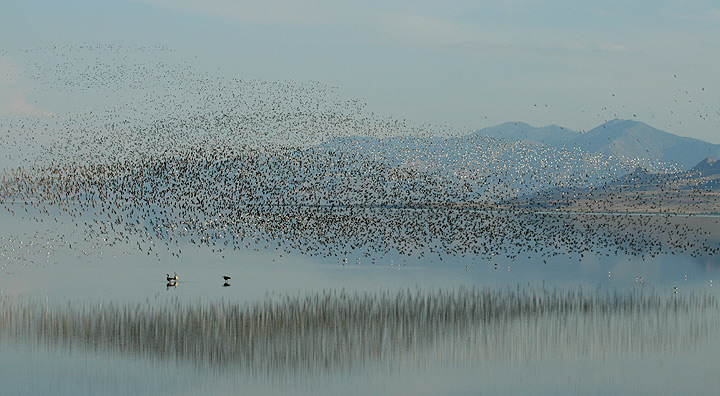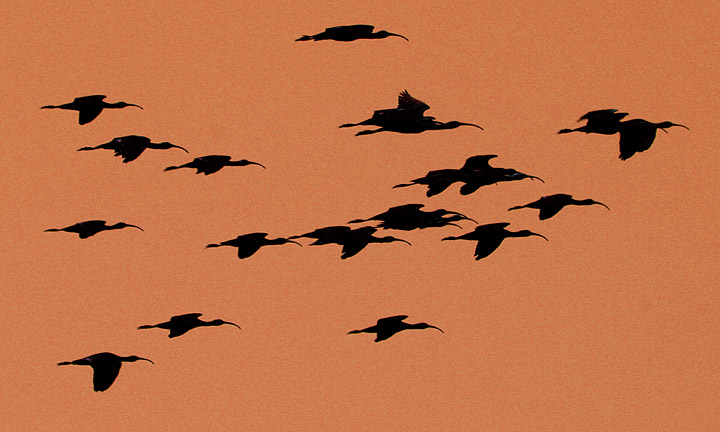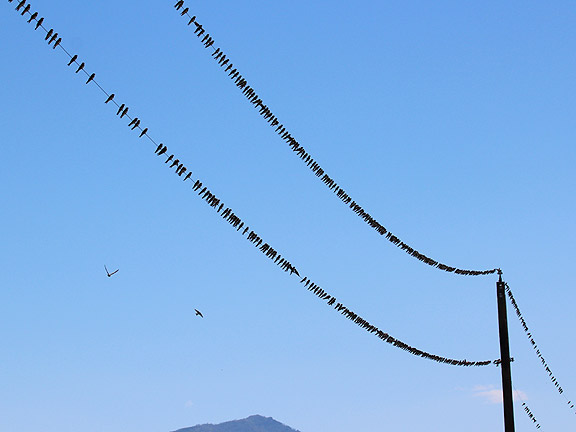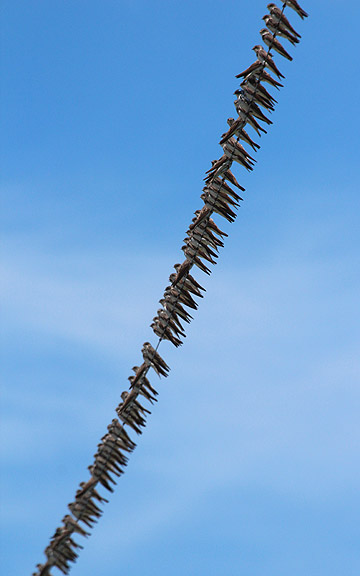Utah Birds, Utah Birding, and Utah Birders. Promoting the sharing of information, and the conservation of habitat for birds in Utah and elsewhere. We are a group of people who want to share what we know, and create a positive birding experience in Utah.
BIRDERS BLOG
a blog by and for Utah Birders
Where are the Wilson's Warblers...
posted by Tim Avery at
8:44 PM
on Wednesday, August 31, 2011
If you've been out birding along the Wasatch front in the past couple of weeks you may have noticed a common migrant missing from the picture. This August the Wilson's Warblers just aren't around like they normally are. Usually the last week of the month sees the greatest influx of these migrants as they head south, but this year it hasn't been that great. In eBird there have only been 2 reports entered all month in Salt Lake, Davis, Utah, Weber, and Box Elder County. Compare that to the history for this species in Utah and you can see serious differences. Check out the graphic below:
Well spring migration was late, summer was late, and that may very well be leading to a late migration. Should be interesting to see what the next couple weeks bring, and if the height of fall passerine migration is a couple weeks behind. On a side note, about two weeks ago in the High Uintas I saw about half a dozen migrating Wilson's Warblers... Maybe they are sticking to the high country this year!
infographic by author
Video: Broad-tailed Hummingbird
posted by Tim Avery at
3:21 PM
on Sunday, August 28, 2011
It's that time of year again, when the hummingbirds are moving through northern Utah in concentrated numbers, giving us great opportunities to study, watch, photograph, and take video of them as they visit feeders on their treks south. In the past week I have had all 4 of Utah's regular fall migrants in my yard, and today spent some time watching the Broad-taileds as they fought over the sugar water with the Black-chinnned. This video was the best I was able to capture.
Labels: backyard birds, hummingbirds, video
The Moose in Lamb's Canyon
posted by Jeff Bilsky at
9:47 PM
on Thursday, August 25, 2011

In need of an adventure, I took to the mountains this evening. Lamb's Canyon is one of my favorite places to go hiking. It is mainly a narrow chute of a trail winding in a fairly steep manner up to a western overlook. The trail is flanked by the canyon waters on one side and a steep incline on the other. Aspens and conifers abound and for the most part, hikers do not. It's exactly the kind of place I like to go when I'm looking to do some thinking or unwind or just get away for a bit. The trail is clearly used by the creatures of the woods as well; specifically moose tracks are all over it. In addition to the moose and mule deer I've seen in this canyon the bird life is great. Owls, Thrushes, Towhees, Flycatchers, Kinglets, Warblers, Nuthatches, Woodpeckers, Vireos and the list goes on. On this particular evening, I wasn't necessarily expecting to see much. By the sound of it (or lack thereof) the Thrushes have for the most part vacated. This is unfortunate because the sound of singing thrushes is truly unparalleled in my opinion. Highlights, however, did include several Golden-crowned Kinglets, Red-breasted Nuthatches, Mountain Chickadees, a Broad-tailed Hummingbird gorging for an imminent migration, a Common Nighthawk at the summit at dusk, a Cooper's Hawk perched in a dead conifer and a handful of Macgillivray's Warblers and Dark-eyed Juncos. I reached the summit right around sunset, knowing I'd have a long, dark hike if I lingered long but I couldn't help myself. As I struck down the mountain after snapping a few pics, the light began to disappear and before I knew it I was reaching for my small flashlight. There really is nothing like being alone in the dark in the mountains knowing no one is around. It's exhilarating and terrifying but you sure know you're alive. I knew I'd run into a moose at some point, I just hoped it wouldn't be in the trail since they rarely get out of your way when they've picked a spot. Sure enough, as I came around a bend I heard a tremendous crashing in the woods to my left. There is nothing subtle about a moose; when they move, they crunch and crush. My small flashlight found the eyes staring at me. I issued a quick "hello, how you doing, just passing through" and bolted past the moose and down the trail keenly aware that moose attack more people than bears and wolves combined. Of course I still had quite a bit of hiking to do to get back to my car and knew there could easily be another moose or who knows what else. So began the "Hey Moose, Hey Bear, Hey Lion Hey Hey Hey" for what seemed an eternity. As an amusing aside, I noticed that the way I called it out sounded very much like a vendor at a baseball game: "Moose Moose Moose, Hey Hey Hey Get Your Moose Here".
Perhaps this whole adventure was foolhardy but I'm not sure life is meant for anything else.

Labels: commentary, Hiking
Atlantic Coast Birding 2: Patteson Pelagic
posted by Ryan O'Donnell at
11:58 AM
on Monday, August 22, 2011

On Saturday and Sunday (30 and 31 July 2011) of my quick four-day trip to the Atlantic coast, we joined Brian Patteson on two of his famous pelagic trips out of Hatteras, North Carolina. Hatteras is the point of land in the U.S. that is closest to the Atlantic continental shelf and to the warm tropical waters of the Gulf Stream, so it is the best place to search for tropical seabirds.

NOAA image, accessed from wikimedia commons.
The first pelagic bird of the trip, a Cory's Shearwater, was a lifer for me, as were most of the species we saw on the open ocean. Craig Fosdick and I estimated a total of about 200 of this species on the first day and 100 on the second day, but we did not actually keep a count. In reviewing my photographs, I found that most of the 20 or so birds I photographed were of the Scopoli's subspecies, which breeds in the Mediterranean, rather than the borealis subspecies, which breeds in the Atlantic Ocean. Note the white tongues on the primary feathers, where a borealis bird should have primaries that are entirely or mostly black with small, diffuse white tongues at the most.


Two other shearwater species were much less common, but we estimated 10-30 of each of these on each of the two days. Audubon's Shearwater nests in the Caribbean and is the smallest shearwater regularly seen in North American waters.


Greater Shearwater breeds on islands of the southern hemisphere and migrates into our northern waters when it is not breeding. Despite its name, it seemed to me to be a little smaller than Cory's. My field guide says that it has a longer body, but a shorter wingspan.


The most common seabird species we saw was Wilson's Storm-Petrel. We estimated 300 or so on each day, but it was tough to make an accurate estimate because there were always a few of them following the boat. We were constantly watching out for other, rarer species like Band-rumped, Leach's, White-faced, or European Storm-Petrels, but I never saw any of these. (The trip leaders spotted two Band-rumpeds quickly flitting past the far side of a large flock of Wilson's, but neither Craig nor I were able to pick them out before they disappeared into the distant waves).

One of the highlights for me was also a specialty of this area, the Black-capped Petrel. This is the only regularly-occuring member of the genus Pterodroma in North American waters. It breeds in the Caribbean and forages in the Gulf Stream. We saw about 12 of these on our first day and about 20 on our second day.



By far the rarest bird of our pelagic adventures came on the second day. We had just come into a big flock of shearwaters and there were fish all around the boat. Others had told me that tropicbirds are attracted to activity of fish, boats, and other birds, and will often fly in high over the boat, so they can sometimes be missed if you're watching the birds on the water too closely. Each time we got into a situation like this, I tried to remember to also check the sky above us. As I peeked up from the shearwaters off the bow and looked behind me over the captain's wheelhouse, I saw the distinctive shape I was looking for. I yelled out, "TROPICBIRD!!!!" and before I could finish the word two or three other people were yelling the same thing. A beautiful adult White-tailed Tropicbird graciously made several circles around the boat before heading off towards the horizon.


All images copyright 2011 by Ryan P. O'Donnell except the illustration from NOAA.
Labels: Brian Patteson, North Carolina, pelagic birding, petrel, shearwater, storm-petrel, Travel, tropicbird
Dowitcher Identification
posted by Tim Avery at
8:34 AM
Yesterday morning I spent about an hour at Ouray National Wildlife Refuge in Uintah County, enjoying what is some of the best shorebird habitat I have ever seen in the county. Some of the units have mudflats and shallow water right next to the road unlike any other time I have been there. In turn there are plenty of shorebirds close enough for good viewing. I will have a full post about the trip later but wanted to get some feedback on a couple of dowitchers I saw. When looking at the birds I felt they were long-billed dowitchers.
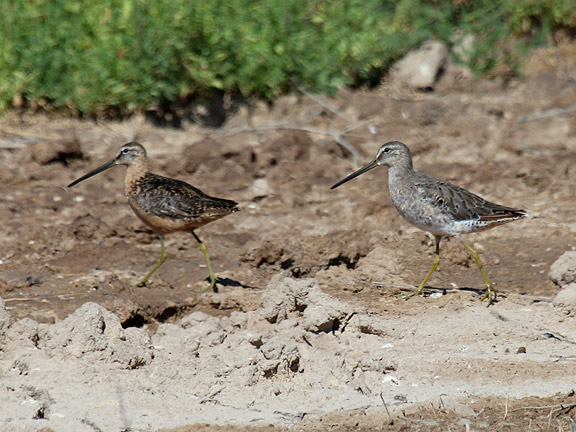
One bird had already molted almost completely into basic plumage, and the other was at the beginning, with a gray hood and mostly rufous body. Neither had obvious barring on the sides, or spotting on the necks The bird that had already molted did appear lighly barred on the side but what would seem in range for a LBDO. The coverts appeared to have nice wide edges clear on quiet a few feathers--not sure whether that is god for one or the other. As for shape the birds looke fairly falt backed when hunched over, but maybe not out of range for a LBDO? Here are some photos (about 5 mixed in with other stuff near the top):
when the birds flew they each gave a 3 note tu-tutulu call which when I heard it in the field sounded like a SBDO. After getting home and hearing it again, I think it may just be a really fast wik wikiki call for a LBDO. It doesn't sound as crisp as a SBDO, and more drawn out like a LBDO. In any event, I listened to it over an over and I am fairly confident it isn't a SBDO, to go along with the visual marks, but wanted some second thoughts. Usually when I see dowitchers, there are so many that the sound is a garbled mess so making out distinct call notes is kind of hard.
Comments would be appreciated.
Cheers
Tim

One bird had already molted almost completely into basic plumage, and the other was at the beginning, with a gray hood and mostly rufous body. Neither had obvious barring on the sides, or spotting on the necks The bird that had already molted did appear lighly barred on the side but what would seem in range for a LBDO. The coverts appeared to have nice wide edges clear on quiet a few feathers--not sure whether that is god for one or the other. As for shape the birds looke fairly falt backed when hunched over, but maybe not out of range for a LBDO? Here are some photos (about 5 mixed in with other stuff near the top):
when the birds flew they each gave a 3 note tu-tutulu call which when I heard it in the field sounded like a SBDO. After getting home and hearing it again, I think it may just be a really fast wik wikiki call for a LBDO. It doesn't sound as crisp as a SBDO, and more drawn out like a LBDO. In any event, I listened to it over an over and I am fairly confident it isn't a SBDO, to go along with the visual marks, but wanted some second thoughts. Usually when I see dowitchers, there are so many that the sound is a garbled mess so making out distinct call notes is kind of hard.
Here is the video:
Cheers
Tim
Labels: identification, shorebirds
Birds are Beautiful
posted by Jerry Liguori at
4:57 PM
on Sunday, August 21, 2011
 Most birds are beautiful, almost unreal in their plumage pattern. However, some are just downright ugly. Look at the beady eye, wrinkled head, and strangely-shaped bill of this Black Vulture...c'mon, the bird is hideous.
Most birds are beautiful, almost unreal in their plumage pattern. However, some are just downright ugly. Look at the beady eye, wrinkled head, and strangely-shaped bill of this Black Vulture...c'mon, the bird is hideous.Any comments on the most beautiful or ugliest bird you can think of are welcome.
Labels: vultures
Flocking up for Migration
posted by Tim Avery at
2:29 PM
on Friday, August 19, 2011
It's the middle of August and if you have been out birding lately, you may have noticed a number of species "flocking up" for fall migration. In particular some very easy to see and abundant species found along the Wasatch Front and the Great Salt Lake are gathering in somewhat staggering numbers. This ritual takes place each fall as the birds prepare, or are on their way south for the winter.

Wilson's Phalarope can be found right now along the Antelope Island Causeway in what could be described as unimaginable numbers. So many birds, as far as the eye can see that it almost doesn't seem real. 500,000; maybe a million birds all within viewing distance of the road does seem unimaginable, but it's real, and happens each year.
White-faced Ibis are typically found around the edges of fresh water marshes this time of year, anywhere with food will suffice. If you were to drop by the south end of Utah Lake you might see hundreds or thousands in flocks devouring everything in sight, getting ready to lift off and head south. Often this time of year, one can visit the Salt Lake International Center in the evening, and see flock after flock of ibis leaving the Great Salt Lake area and heading south out over the Salt Lake Valley. It's kind of a cool experience to watch.
Bank Swallows are very particular about where they nest. During the breeding season, unless you visit a colony, this species can be hard to find in Utah. During migration they are far more common and often seen in flocks of 1,000's of birds. Along the Antelope Island Causeway and other roads with a high density of insects for the taking you may see fences, power lines, and road barriers covered in swallows as they rest between forays to feed. Just yesterday I saw close to a 1,000 on a random side road in Utah county where most of the year any swallow would be hard to find.
So why do these birds flock up? There are a couple of theories that are widely believed to be true. For starters some believe that when in flight, the shape a flock makes may make be more aerodynamic than a single bird in flight, saving energy for individuals as the mass moves together. Another common belief is that safety comes in numbers. It is true that if you are alone on a journey you may be a far easier target, than 1 in a 1000 traveling together. Yet a third theory is that it may be easier for a larger group of birds to find food than an individual. With more mouths and eyes in search of food, it could make it easier to find the energy filled fuel these birds are in need of for their trips.
What are some of your favorite "flocking" experiences with birds?
Labels: migration, shorebirds, swallows, waders
Birding the Atlantic Coast 1: Dismal Swamp and North Carolina's Outer Banks
posted by Ryan O'Donnell at
6:27 PM
on Tuesday, August 9, 2011

Last week I took a short trip with Craig Fosdick to do some pelagic birding off the coast of North Carolina. We arrived on Thursday night and were anxious to start the birding. After a quick stop to drop off some gear at the hotel, we headed straight to the Great Dismal Swamp, a famous birding location in southeastern Virginia. Although it was hot - 98F and very humid - some birds were still active. My first lifer of the trip was a singing Acadian Flycatcher, the first of several that day. Not much longer, we spotted a few of one of my most wanted species for the trip: Prothonotary Warbler. Other typically eastern birds were seen and heard, including a Wood Thrush, several Yellow-billed Cuckoos, several Carolina Wrens, and many Eastern Wood-Pewees. For the full list from eBird, click here. We went to bed early in preparation for more birding on Friday morning, along the 3 hour route to Hatteras, where our pelagic trips would start on Saturday morning.

The next morning, our first stop was at the Palmetto-Peartree Preserve. This private land is a preserve for the endangered Red-cockaded Woodpecker, our target species of the stop, and is also excellent habitat for Brown-headed Nuthatches. We got a little lost from a poorly-drawn map, but still managed to find both of these species near the Preserve, although at the time we thought we were in the preserve. I saw my lifer Prairie Warbler the day before at the Great Dismal Swamp, but got good looks at a few more here. One of the highlights of the trip for me was seeing my lifer Southern Leopard Frog here, a species that is closely related to the one on which I'm writing my dissertation. Here is a link to all the species we saw at this location.



We stopped at a few more Outer Banks birding locations on the way down to Hatteras, and I picked up my lifer White Ibis and Tricolored Heron at the Bodie Island Lighthouse Pond and then my lifer Piping Plover at Pea Island NWR. It was another early bedtime in preparation for the boat trip the next morning, the main point of our trip.

(To be continued . . . )
Labels: North Carolina, Travel, Virginia
Roughies From Above
posted by Jerry Liguori at
7:49 PM
on Monday, August 1, 2011



The best way to tell dark-morph from light-morph Rough-legged Hawks from above is that dark birds have all-dark tails (with or without narrow, whitish bands), and light birds have a white base to the tail. Simply...only light birds have the white tail base on top. However, a few light-morph birds have very limited white to the topside of the tail. Note the tail pattern of the light-morph bird on the bottom left compared to typical light-morph tails (middle and right).
I added some dark-morph photos above the light birds per request of Robert. Note the dark topside to the tail on the middle (adult female) and right (juvenile), and the narrow but bold white tail bands on the adult male (left).
Here is a gorgeous photo of a dark juvenile (top) that was taken by my friend Vic Berardi....check out the paler smudgy bands on the top of the tail shown by some dark juvs, and the pale primary "panels" or "windows".
Labels: identification, raptors

